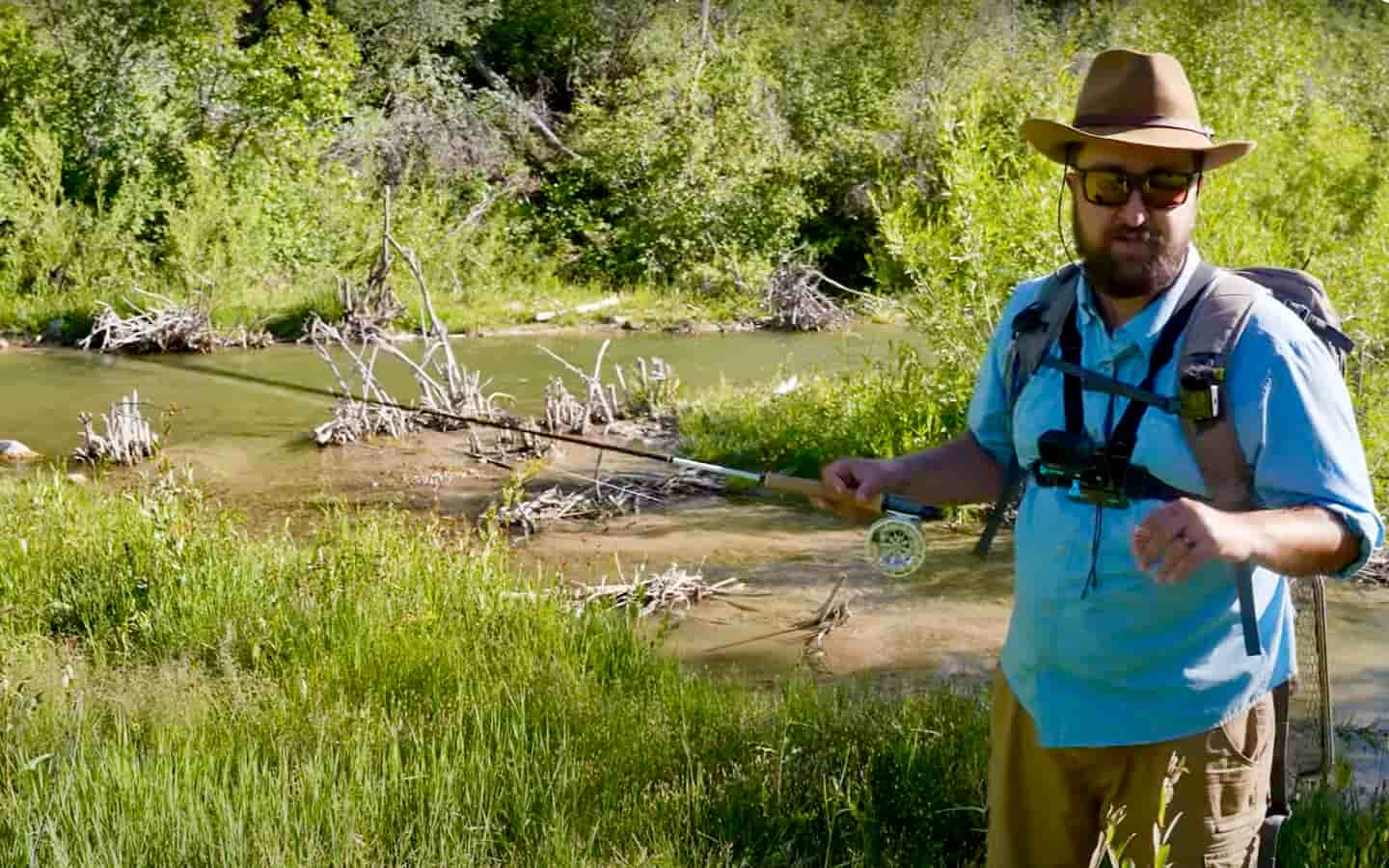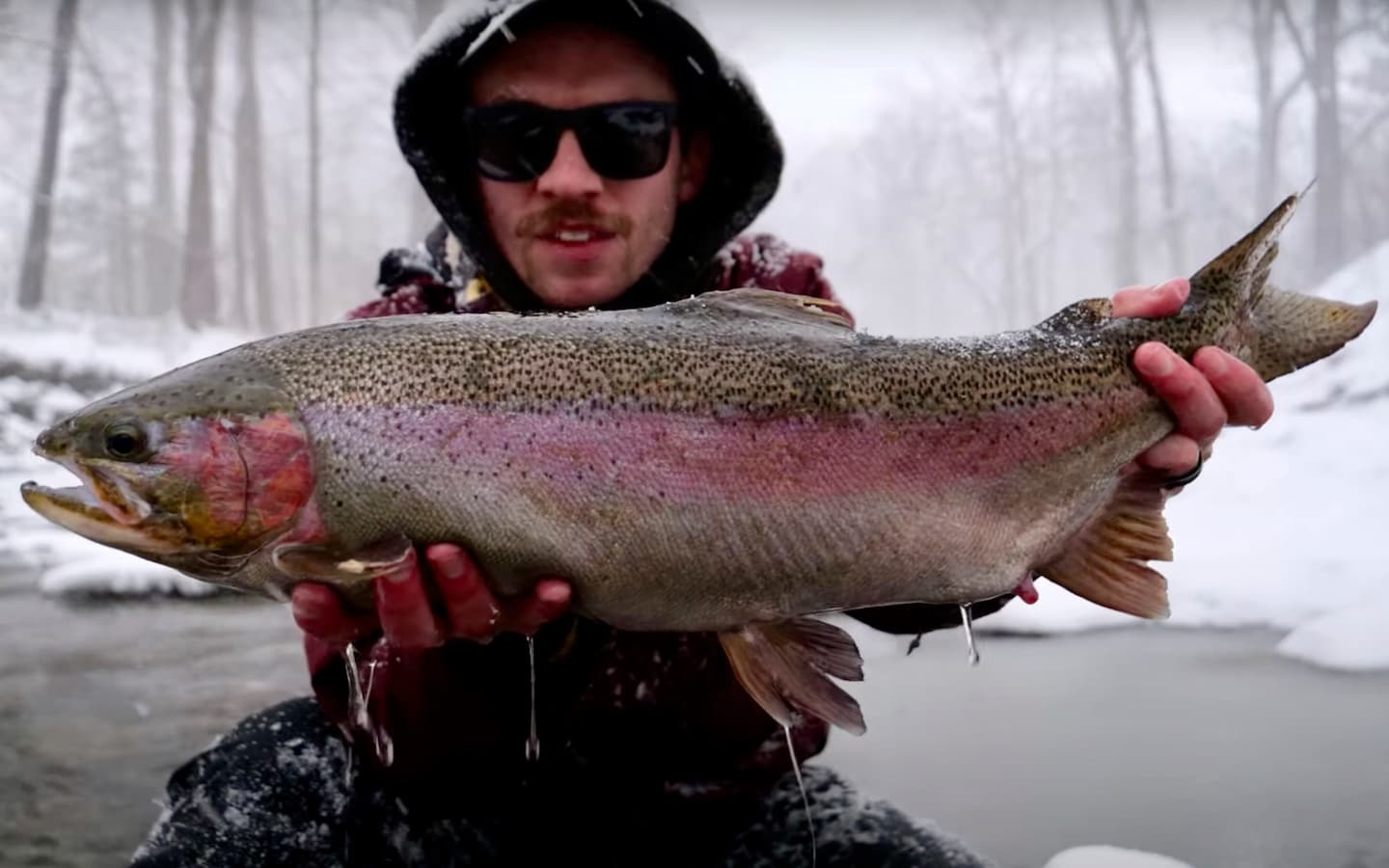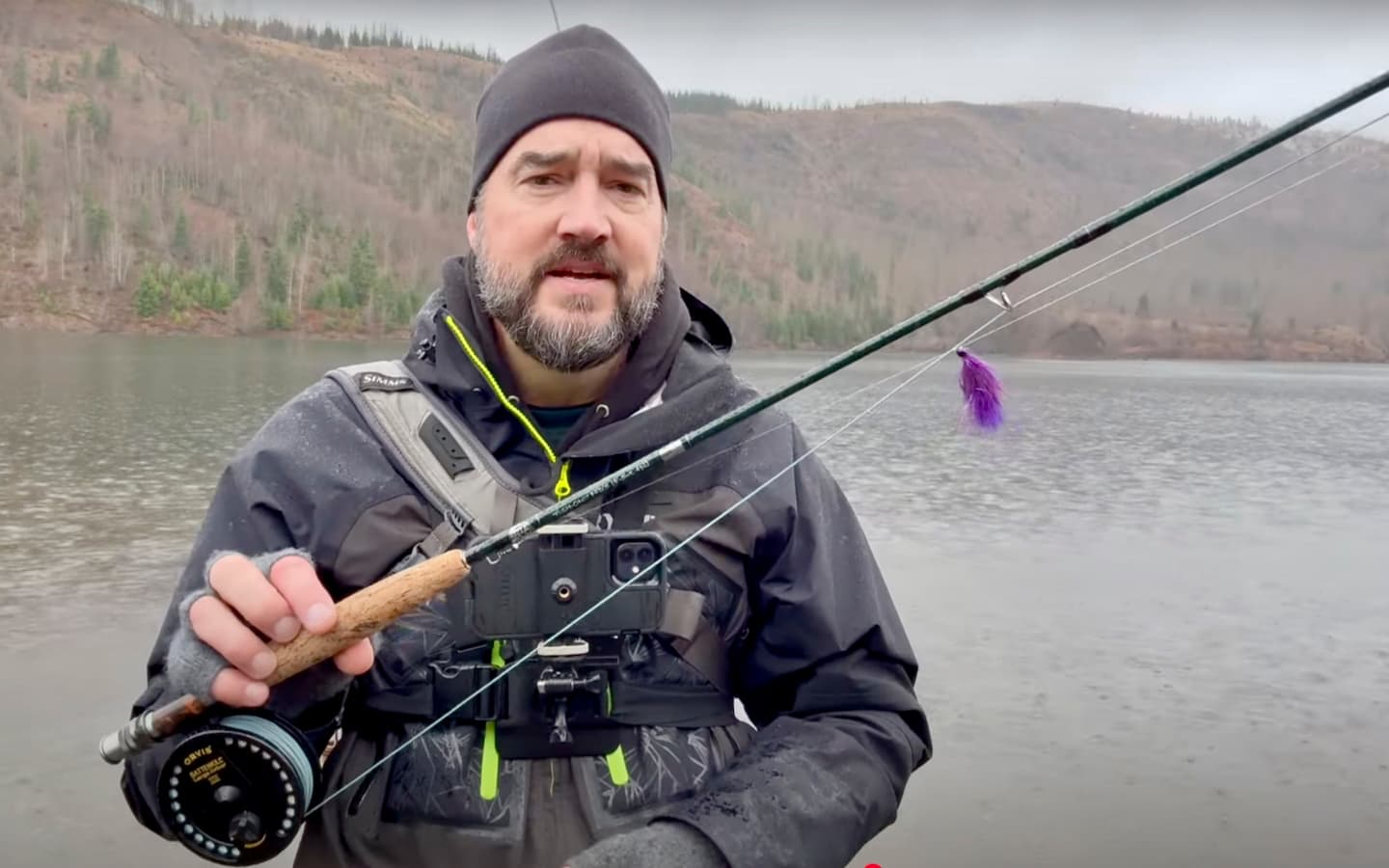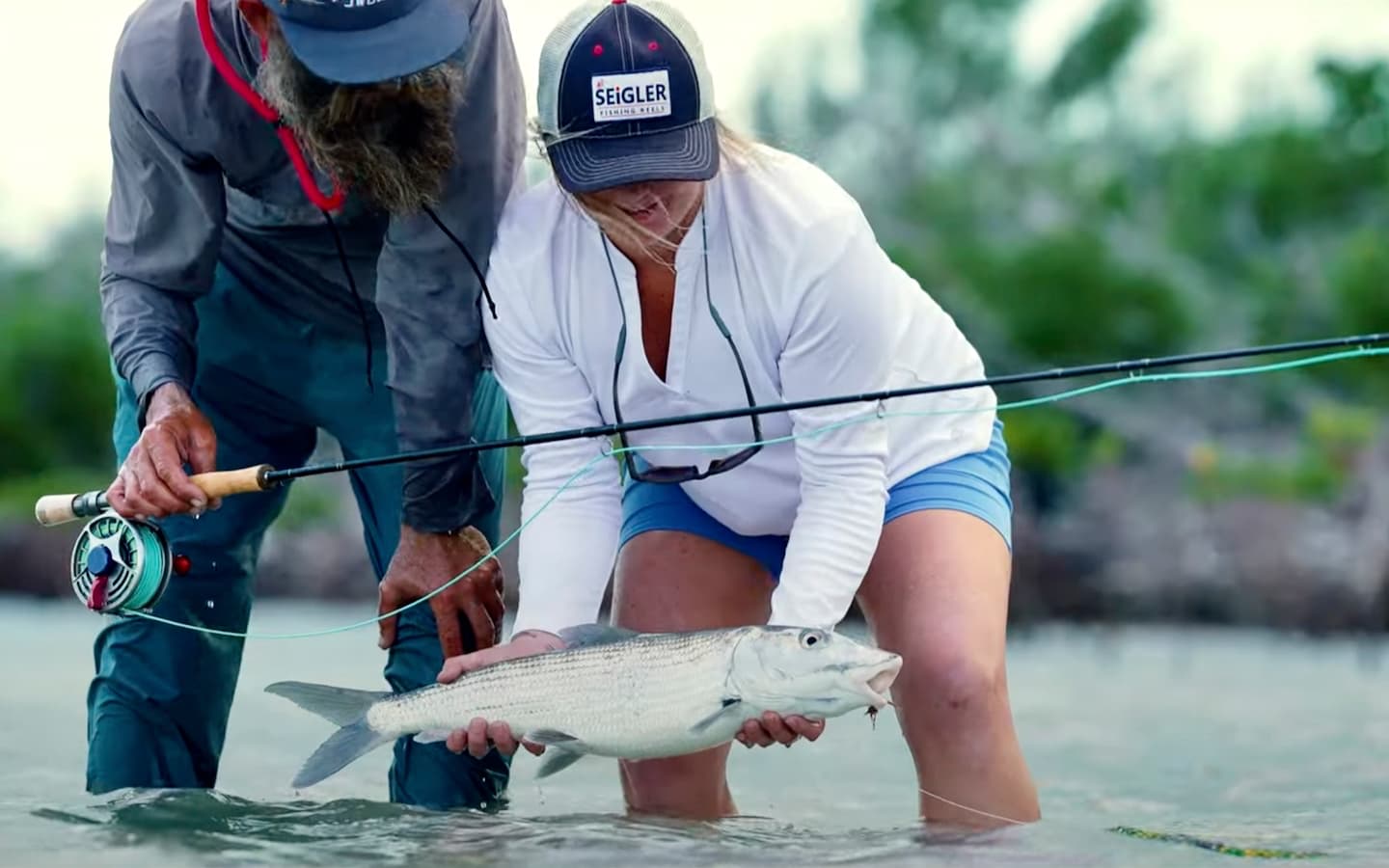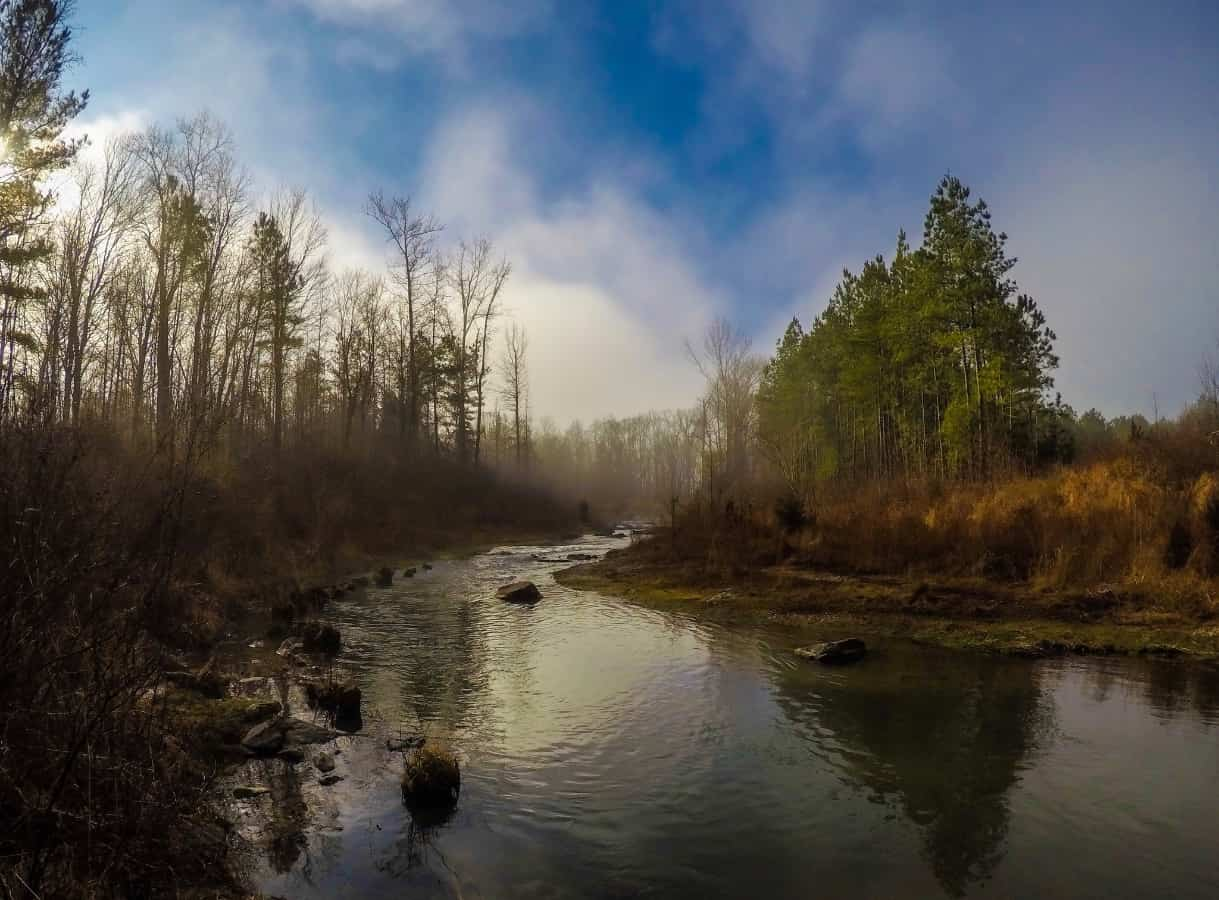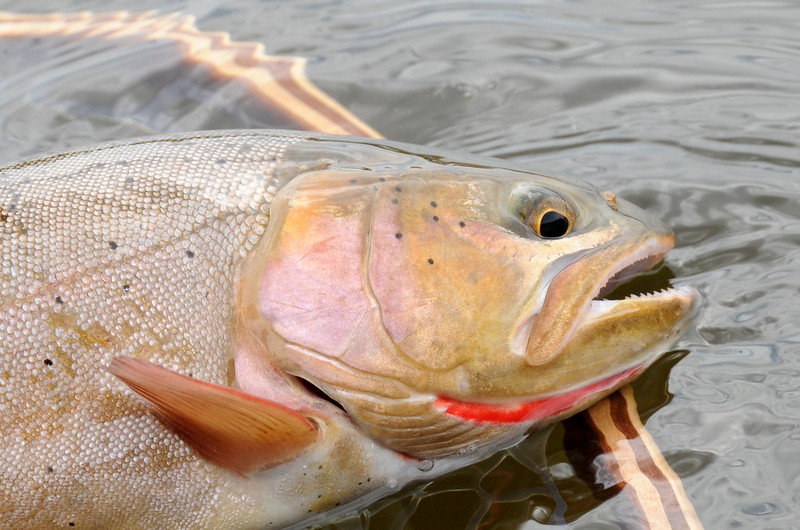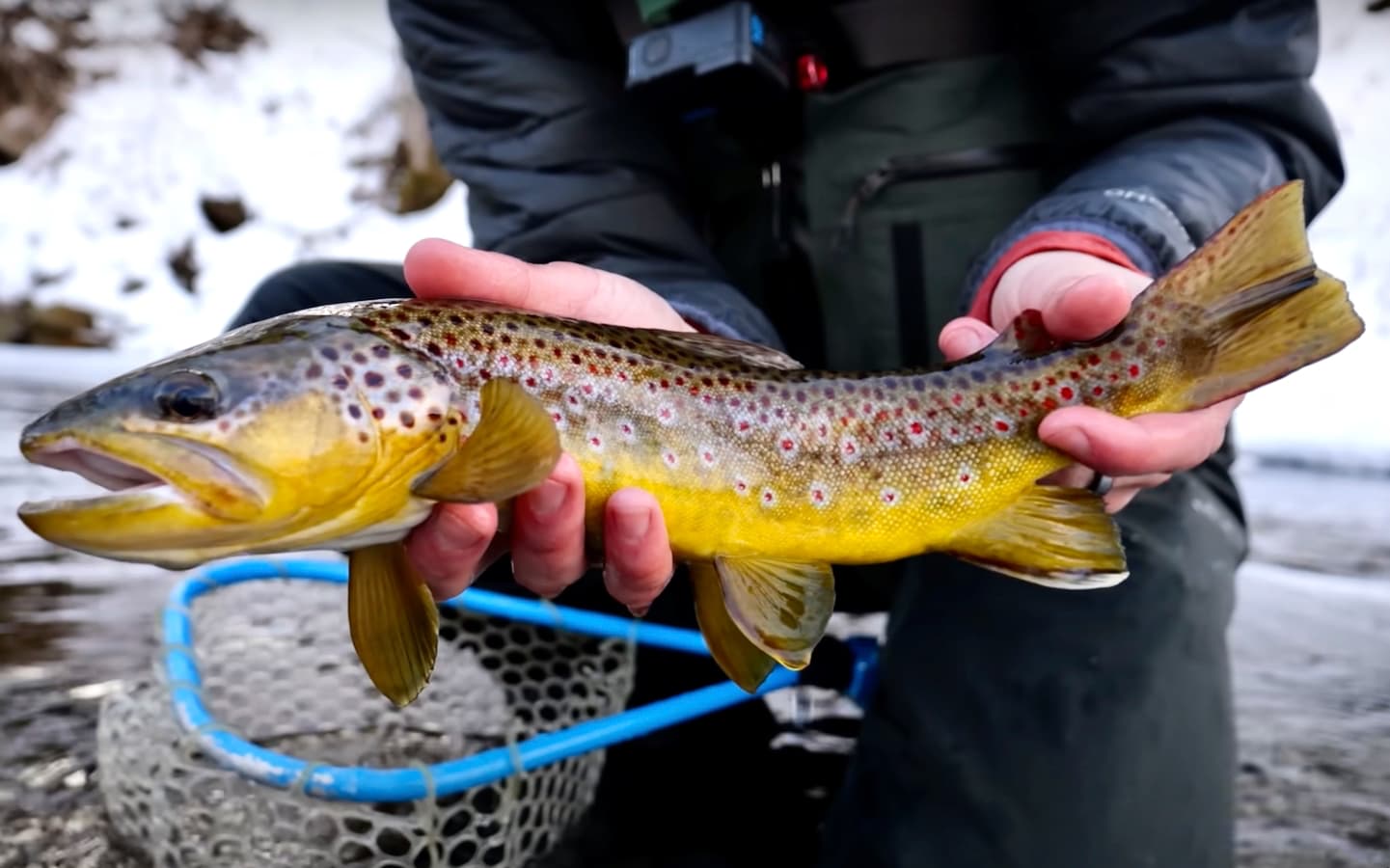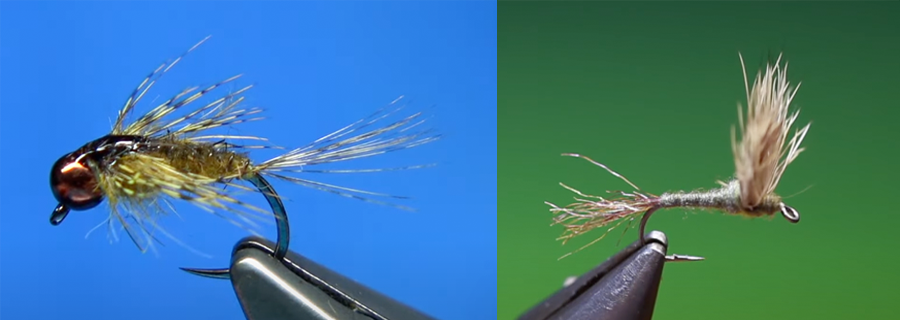Tideline: Rick Murphy
 IN THE EVERGLADES, you can smell a good tarpon day when it is about to happen. There is a sweet early morning scent, the fragrance of lacy white flowers from Spanish stopper trees suspended in the humidity, woven through the mangroves and hanging over the flats. The smell is only there when the wind, moisture, and heat are right, and its presence is a sure harbinger that, when the tides move, the big fish will be rolling.
IN THE EVERGLADES, you can smell a good tarpon day when it is about to happen. There is a sweet early morning scent, the fragrance of lacy white flowers from Spanish stopper trees suspended in the humidity, woven through the mangroves and hanging over the flats. The smell is only there when the wind, moisture, and heat are right, and its presence is a sure harbinger that, when the tides move, the big fish will be rolling.
It is late July, hideously buggy, and a series of thunderheads tower like gray and black anvils above Florida Bay, bouncing soft strobes of light out and over the miles of dark, uneven water.
Standing at the Flamingo boat ramp, Rick Murphy is deciding whether he wants to fish “inside” or “outside.” The professional redfish tour is in town. A handful of boat captains—the competition—waits in the staging area near the ramp, their silhouettes highlighted by the morning moonlight, distant lightning, and sporadic embers from their burning cigarettes. They think Murphy is going scouting.
A typical day in Flamingo offers many options. You can work the backcountry mangroves for snook, or cut out to the keys and basins, hoping to find redfish on the oyster bars and edges. Of course, you also can chase after bonefish on the sandy, turtlegrass flats.
But the first deep breath of humid morning air already had confirmed Rick’s plan. We are going after tarpon. We will fish inside, he says, push Coot Bay, then through Whitewater Bay toward the northwest, and go as far as we have to, maybe as far as Shark River Island. This way, we can dodge the rain and lightning storms if we have to, and take advantage of the last two hours of a falling tide.
Murphy is on a mission.
 “Oh, we’ll get into some tarpon today,” he says. “I can smell it. I’m not sure how we’ll catch ’em, or where we’ll catch ’em, but I’m not worried. Trust me.”
“Oh, we’ll get into some tarpon today,” he says. “I can smell it. I’m not sure how we’ll catch ’em, or where we’ll catch ’em, but I’m not worried. Trust me.”
Running north from Flamingo, through one of many channels cut by Flagler’s barges, we emerge into a small bay obscured by a light morning mist and walled in with dense stands of dark green, almost black mangroves. The surface of the tannin water along the near east edge is ringed almost entirely with life, like a kettle of bubbling soup, indicating the presence of fish, massed in a disorganized school, maybe two acres long. It is a curious sight, more akin to trout gulping callibaetis on Hebgen Lake, than anything we had seen in warm water.
“Who wants to catch the first tarpon?”
“Tarpon?”
“Yeah, this is the nursery, the playpen. Grab that six-weight fly rod, and put on a small Clouser. We might as well teach them while they’re young.”
We pause before making our first casts, long enough to notice that these fish are playing out, in miniature, the same routine of the grownups, daisy-chaining in distinct circles, gulping air, and milling through the shadows in search of bait.
It only takes a few casts to iron out the kinks, and the small green and white streamer grabs the attention of a baby tarpon, who inhales it with hereditary vigor, and just like its bigger brethren, vaults straight into the air with a violent shimmer. We trade shots from the bow for an hour or so before three alligators drift nonchalantly into the mix, attracted by the distressed splashing and pretending as if we don’t notice them, but not really caring if we do. When the largest gator, roughly six feet long, drifts to within 20 feet of the boat, Rick says it is time to take off and let things settle down.
“See, I told you we would have a 20 tarpon day!” he shouts. “Are we done? Did you get what you wanted?”
“Maybe not.”
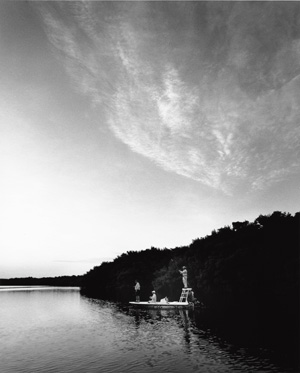 “Me neither, let’s go find a big one.”
“Me neither, let’s go find a big one.”
Two large tarpon free jump on the west side of Oyster Bay. Rick kills the engine and climbs onto the poling platform. They’re in here, he says, so be patient. Whisper. Don’t move your feet, and don’t bump anything. Coil up the fly line on the deck. Hold the Cockroach in your hand. Don’t bother blind casting in this stained water. The odds that your false casting and line commotion will hurt us outweigh the odds of teasing up one lonely, indiscriminate bite. We will wait until one rolls in close, then lead him with a cast, start stripping, and pray.
We see a player. The fish porpoises at 11 o’clock from the bow and is heading right, no more than fifty feet away, and almost close enough to count the hundreds of aluminum-to-green scales densely packed along its rolling flank and back.
When he eats the fly, the world changes in one second. What had been utter silence, except for the slicing whisper of a fly line overhead, explodes with the terrified, gill-rattling contortions of the tarpon going airborne. The fish jumps three, four times like successive, molten silver shots from a giant Roman candle, each time crashing lengthwise against the surface, sending echoes like cracking timber over the flat.
“Run Forrest… RUN!!” Rick laughs, as the fish charges at the mangrove shoreline.
It isn’t a terribly large tarpon, maybe 60 pounds. Yet, he packs more than enough staying power and tenacity to humble the trout bum on the bow, who stammers a chain of epithets at himself and the tarpon, as his face turns red and his neck arteries bulge with the strain on the rod. Poor bastard, Rick says, he’s ruined. He’ll never be the same again. A tarpon will change a man’s life forever.
“Breathe, man, don’t forget to breathe,” Rick instructs through a contented, “welcome to my world” grin.
For 20 minutes or more, the fish shows little quit, running in circles around the boat, warping the 11-weight rod near its breaking point, and shuffling the three of us around the deck in a Keystone Kops routine. Finally, Rick grabs his yellow tarpon gloves.
“Now go around the bow. The front. The other front,” he says. “Okay, hang on, gimme that leader, we got him now.”
 For Rick Murphy, fly-fishing is a business, and he won’t apologize for utilizing the sport as a way to earn a generous living for both himself and his family. You can resent him for his slick boats, his television show (Sportsman’s Adventures with Captain Rick Murphy, which airs on the Sunshine Network), his sponsorships, magazine covers, advertisements, and his house full of trophies won both as an angler on the pro redfish tour and as a winning fishing tournament guide, but in the end, he has learned how to make a living by doing something he loves, and it is hard to fault him for that.
For Rick Murphy, fly-fishing is a business, and he won’t apologize for utilizing the sport as a way to earn a generous living for both himself and his family. You can resent him for his slick boats, his television show (Sportsman’s Adventures with Captain Rick Murphy, which airs on the Sunshine Network), his sponsorships, magazine covers, advertisements, and his house full of trophies won both as an angler on the pro redfish tour and as a winning fishing tournament guide, but in the end, he has learned how to make a living by doing something he loves, and it is hard to fault him for that.
His passion is genuine; his skill precise and apparent. After all, there are no “gimmes” on the Florida flats. Rick doesn’t just talk the talk, he walks the walk, and after 10 minutes in his boat, even the most novice angler can figure that out.
“There are differences between going fishing, guiding, and making a career,” says Rick. “Everyone should be allowed to take their passion and interest to whatever level they choose and are able, without all the politics and backstabbing, but that’s all part of the game.”
In Rick’s case, it starts with his firebrand intensity, the likes of which none of us has ever encountered before. The atmosphere on the boat is always jovial, humorous, sometimes downright raunchy, but when it’s money time, Murphy calls the shots. “This is a war,” says Rick, “and we’re always on the offensive.”
The man has been known to bite sharks, and tarpon fishing, where you try to find, hook, and land fish with the size and power of personal watercraft in 10 feet or less of water, he says, is not a finesse game, fly rod or not.
“When you hook that fish, you gotta fight him like you want to rip his face off,” he explains. “He’d rip yours off if he could. You give the fish one break, you let yourself lose control, and he’s gonna turn it on you.
“You gotta remember they think they’re gonna die. For the tarpon it’s always a fight to the death. They don’t know we’re gracious, and they don’t expect mercy, so don’t give them any until that last moment, when you look into that big black eye and decide to send ’em home.”
Without his unrelenting intensity, it is hard to imagine that Rick Murphy could have achieved the fishing success in south Florida he has. Not only is flats guiding a technically difficult, physically demanding, and meager paying profession to break into, but a young, green entrepreneur also must find his niche in the thriving Keys and Everglades “old boy” network, where weathered veterans still guard flats like cattle barons fending off rustlers. This is hallowed water, and it should require more than a cell phone, a captain’s license, and a flats boat to call yourself a Florida flats guide, but no one has any idea, says Rick, how truly difficult it is to break in down here.
Yet every season a fresh wave of young guns and displaced Yankees flock down to south Florida in droves, each figuring they have found tropical paradise, lots of fish, and a perfect place to hang a shingle. But Rick points out, it isn’t the good ones, or the tough ones, who last. The captains who make it here are both good and tough, and natural selection usually sends the others packing.
 Respect is the dividing line. Rick had mentors to teach him that—people like Stu Apte and Al Pflueger, Jr. Back in the 1970s when the sport really took off, the founding members of the Miami Sportfishing Club laid out an unwritten protocol for fishing and guiding—how much space you should give another boat on a flat, how to approach tailing or rolling fish without cutting off others, where to motor, where to pole, and so on. Understanding and adhering to the protocol is the first step to survival, Rick says, but sometimes, the last test is being willing to stand your ground.
Respect is the dividing line. Rick had mentors to teach him that—people like Stu Apte and Al Pflueger, Jr. Back in the 1970s when the sport really took off, the founding members of the Miami Sportfishing Club laid out an unwritten protocol for fishing and guiding—how much space you should give another boat on a flat, how to approach tailing or rolling fish without cutting off others, where to motor, where to pole, and so on. Understanding and adhering to the protocol is the first step to survival, Rick says, but sometimes, the last test is being willing to stand your ground.
He explains how he once was crowded off a run full of tarpon by a well-known veteran, who knew full well how the system worked but wanted to flex some muscle and back Rick down. An uncomfortable shouting match was avoided on the water, but later that evening, Rick called the man to inform him he was standing on his boat with six gallons of gas and a lighter, and was ready to “go to work” if they didn’t have a talk to sort things out. No boats were burned, thankfully, but Rick was beginning to earn (with this act and others) the hard-fought room to operate on the increasingly contentious flats.
“I tell young guys who ask me about guiding in Florida that they better be willing to play by the rules, but to never back down if the line gets crossed,” says Rick.
“These new kids would make things a lot easier on themselves if they would just head down to Islamorada for their first season, pick out the toughest flats guide they can find, and beat the shit out of him. At some point, everyone has to stand their ground, and I’m not sure there’s any reason in waiting 10 years to do it.”
“Why are your hands shaking?” Rick asks.
“Nervous.”
“What for?”
“I’m not sure, but how could you tell?”
“It’s my job. A guide is supposed to know what’s going on all around the boat, but the most important thing is what’s happening on the bow. A good guide understands the body language of the angler standing up front, and never misses a thing. I want to know what the next cast is going to look like before it happens. I want to know if there’ll be fire coming off that fly line.”
Rick is right. Maybe it is the hot sun, maybe the fumes from the bug spray, but inevitably, you find yourself doing, thinking about, and saying things on the boat you wouldn’t imagine doing or saying at the dinner table, or in the office. In this respect, the bow becomes the barber’s chair or the psychiatrist’s couch, a place to relieve the pressure of everyday life, but also a place to test personal and professional boundaries without the added expectations of formal manners or stilted etiquette. On the bow of Rick’s skiff, for better or worse, you are encouraged to express yourself.
At times, having this personal daily theater unfold in front of him is the part of Rick’s job he enjoys the most.
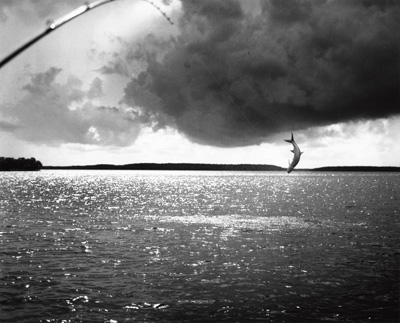 “Some days, you have to wonder what would make a guy climb out of a warm bed and leave the wife and family behind at 4 a.m. You question the sanity of this,” he explains. “I mean, flat’s fishing is hard stuff, harder than most fishing. I’m not out hiding under the T-top like they do on the offshore boats.
“Some days, you have to wonder what would make a guy climb out of a warm bed and leave the wife and family behind at 4 a.m. You question the sanity of this,” he explains. “I mean, flat’s fishing is hard stuff, harder than most fishing. I’m not out hiding under the T-top like they do on the offshore boats.
“But this fishing is about freedom, and my office is 1.8 million acres big. I’m not the police; people are happy to be talking with me. And I get to see people at their best, when they’re having fun, and also when they fail miserably and begin to question themselves. I see it all, but we learn, we get better, and we move on.”
We spend an afternoon pressing further into the Keys in pursuit of some “bullet” bonefish, which means trading in the 11-weights for 8-weights, dabbing on new layers of sunblock, and ripping due south across Florida Bay where the water turns into an aquamarine tapestry of green channels, turquoise depressions, and tan, turtlegrass flats.
Rick poles downwind, looking for muds that indicate schools of bones feeding. We tie on a small brown shrimp pattern while our captain points out a flock of roseate spoonbills perched on a mangrove key, and explains that their bright pink plumage indicates an abundance of shrimp in the warm water shallows.
A half-dozen large bonefish are tailing ahead of us, their fins knifing through the wind-blown surface like cracked pieces of crystal. But they are spooky, and the light has turned against the wind, limiting our shots to opportunistic afterthoughts. It is hard to cut off Keys bonefish once they have made up their minds to avoid your position. “We’ll stick tight and wait for another group,” says Rick. “Chasing them with the boat is the ultimate act of desperation.”
Finally, a lemon shark runs across the flat, promptly displacing our angling opportunities to deeper water. We have half a mind to get out the big rod and throw a fly at him but know without a steel leader, he only will chew it clean off. It isn’t worth the effort or the cost of the fly this late in the day.
We decide to haul out ahead of the afternoon thundershowers and drive back to Homestead. Rick treats us to strawberry and banana-flavored milkshakes at a roadside fruit stand, and we pick up a few fresh mangoes for breakfast. We make a toast to two productive days of fishing, writing, and photography. We have what we had come for, so we ask Rick what he wants to do in the morning.
He just smiles.
“I’ll meet you at the gas station at 5 a.m.”
Rick Murphy isn’t satisfied yet. He says he’ll be damned if his “tarpon shot” is going to be with a 60-pound fish. So we are back at the ramp in Flamingo before first light with a new plan. Rick says it is time to take the gloves off.
“You boys aren’t opposed to a little baitfishing are you?” he asks, then supplies his own answer. “Good. ‘Cause that’s what we’re going to do today.”
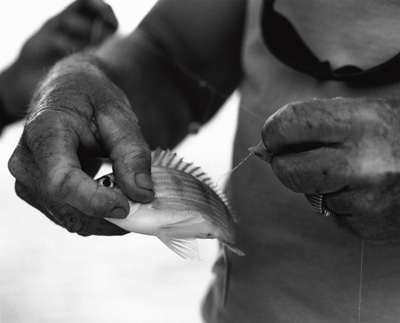 Rick runs southwest from Flamingo toward the Oyster Keys, where he drops anchor, then throws out a small chum bag of frozen shrimp. He fashions two spinning rods with “sabiki” rigs (chains of jig-like hooks on fine leaders, some “freshened” with shrimp), then has us start cranking away for pinfish. The beautifully striped, palm-sized pinfish will be our tarpon bait. Rick says he prefers using sabiki rigs to throwing the net—a net will knock the scales off the baitfish, and he wants the pinfish clean and full of energy.
Rick runs southwest from Flamingo toward the Oyster Keys, where he drops anchor, then throws out a small chum bag of frozen shrimp. He fashions two spinning rods with “sabiki” rigs (chains of jig-like hooks on fine leaders, some “freshened” with shrimp), then has us start cranking away for pinfish. The beautifully striped, palm-sized pinfish will be our tarpon bait. Rick says he prefers using sabiki rigs to throwing the net—a net will knock the scales off the baitfish, and he wants the pinfish clean and full of energy.
It takes maybe 20 minutes before we have a couple dozen pinfish in the live well. Time to pack up and head north along the west side. We will cut through the mangroves and avoid the Gulf and waves.
But before the tarpon fishing starts, Rick idles the boat and pulls up alongside a mangled line of roots in the channel mouth. He sticks a poor pinfish on a steel hook and flips it toward the mangroves. Following the line on the water, we watch as the pinfish wriggles toward the presumed safety of the shoreline, but then abruptly puts on the brakes, spins around and starts wiggling back at the boat. Rick gives it another flip, then another, and each time, the same thing happens.
“It’s just like I thought,” smiles Rick. “There’s a big snook hanging out in those roots. Pinfish doesn’t want any part of him, and lucky for him, the snook isn’t hungry, or he knows we’re here.”
Rick slips the hook out of the pinfish, and tosses him out into the channel, figuring he’s had enough.
“Three tours of duty, and he’s out. One more trip in there and that fish would’ve had a heart attack anyway.”
Eventually, we find the bigger tarpon running down the Gulf’s outside edge, between Middle Cape and East Cape. We stake out with our backs to the shoreline then begin throwing baseball-sized cork bobbers and hapless pinfish out into the Gulf with bait casting rods. We wait and watch as the bobbers drift on the tide, often tracking off in erratic directions, tethered five feet above the nervous bait. A tarpon rolls in close.
At once, the flat erupts like a geyser, sending the bobber flying 30 feet in one direction, the pinfish (or what’s left of it) spiraling 30 feet in the opposite direction, and in the middle, the tarpon and the line shooting straight upward. It’s a big one, over a hundred pounds, Rick shouts, as he cranks up the motor. We will have to run this fish down.
Jump, another jump, and another. “If you remember the jumps, you don’t need anything else. It doesn’t matter if you land them, but we’re gonna land this fish.”
The tarpon first runs deep, then makes a curious turn at the mangrove shoreline. “She’s gonna try to wrap us up, break us off,” mutters Murphy. When the tarpon wraps the line under a marled root, Murphy grabs the rod and threads it back through, never losing tension, and effectively trumping the fish’s last ace.
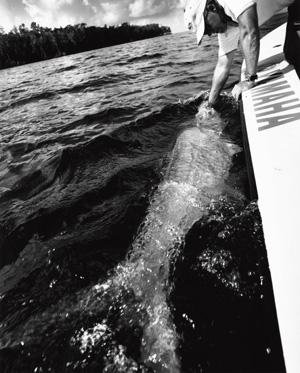 That end game, when Captain Murphy grabs the leader, is when he is the most keyed up. “It’s just you and me baby,” he mutters. Then he clamps down with both hands on the tarpon’s lower jaw and holds it in place. “When Rick Murphy grabs you with his hands, you know you’ve been grabbed,” he smiles.
That end game, when Captain Murphy grabs the leader, is when he is the most keyed up. “It’s just you and me baby,” he mutters. Then he clamps down with both hands on the tarpon’s lower jaw and holds it in place. “When Rick Murphy grabs you with his hands, you know you’ve been grabbed,” he smiles.
As the photographs are made, Rick quietly transitions from hunter to healer, gently rocking the fish back and forth in the water to get the water and oxygen flowing through her gills. Her large, black eyes are terrified and angry; most of her prehistoric scales have faded to a dingy gray. She is played out.
As we watch her slip away, we hope that she finds her strength before a bull shark or a hammerhead finds her. We all agree that we are played out as well.
Riding back toward Homestead, over the hammocks and through the Everglades pinelands, we pass a stand of dwarf cypress, which are telltales, not unlike the Spanish stopper trees, for the tarpon fishing. When dwarf cypress needles start to dry and brown, the tarpon season will begin to wane. It is a signal, says Rick, that winter’s fragile grip on the Everglades and Keys will move the silver kings out to deeper water. He says it won’t last long, and just as certain, the emergence of those first bright green needles on the dwarf cypress in late winter will signal the return of the kings to the shallows.
For Rick Murphy, the seasons, the islands, the flats, and the fish eventually blend together. He has to stop every now and again to look at the signs around him, if only to keep in tune with the ever changing cycles of life thriving on these flats, the Gulf, and throughout the enormous River of Grass.
We offer an invitation to our new friend.
“Hey Rick, you ought to come out and fish with us in Colorado someday.”
He just smiles and says, “Thanks, but you know what I think about when I hear ‘trout’ don’t you?”
“Bait.”
“You got it. Bait. But I’m sure we’ll be fishing together again before much longer… here.”
He is right, as usual. Tarpon change lives.
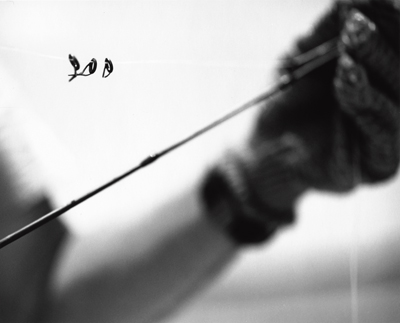 NO GRAND SLAM TODAY
NO GRAND SLAM TODAY
Wait out lightning squalls at dawn, bad cigarette smoke,
Flamingo boat ramp hostility, mosquitoes, borderline small talk
for the remote chance at a Florida Bay grand slam:
a bonefish, permit, and tarpon all leadered in one day.
By two o’clock, the mottled turquoise flats are a blast furnace,
leaving rays and only the sharks to eat, so we’re headed in.
Understand what matters are the day’s results, which are these:
Zero permit, because they only exist in magazines or dreams;
two dozen fork-tailed bonefish spooked, lined, or bored;
thirteen tarpon jumped on baited pinfish, of those,
a fifty and eighty-pound fish landed, but babies hardly count;
a conventional rod stripped of guides then snapped against the boat;
ten sharks broken off, bulldozing toward the horizon.
These things would not be worth anyone’s inventory:
Seventy-five vultures tethered like black kites above Oyster Key;
the erratic way a pinfish swims when he’s ready to be killed;
a burning limb of thunderhead arcing over Coastal Prairie like a warehouse fire;
twenty-five minutes reviving sea into a faded tarpon;
the sharks that will find her by electric smell or death’s emissions;
the empty space of drifting sea she has left behind.
